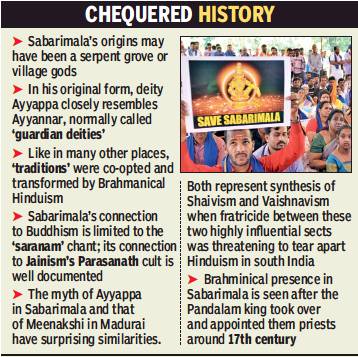Lord Ayyappa
(Created page with "{| class="wikitable" |- |colspan="0"|<div style="font-size:100%"> This is a collection of articles archived for the excellence of their content.<br/> Additional information ma...") |
|||
| Line 33: | Line 33: | ||
But if you look more closely, Sabarimala’s Ayyappa has a close resemblance to Ayyanar, who is worshipped in Tamil Nadu and Andhra Pradesh, says Prof K N Ganesh, a historian at Calicut University. “ Even as Sabarimala has now become a flashpoint for Hindu identity, older layers of the Ayyappa legend, his tribal/hunter-gatherer origins and his worldly, non-ascetic self, have been buried. | But if you look more closely, Sabarimala’s Ayyappa has a close resemblance to Ayyanar, who is worshipped in Tamil Nadu and Andhra Pradesh, says Prof K N Ganesh, a historian at Calicut University. “ Even as Sabarimala has now become a flashpoint for Hindu identity, older layers of the Ayyappa legend, his tribal/hunter-gatherer origins and his worldly, non-ascetic self, have been buried. | ||
| + | |||
| + | =See also= | ||
| + | [[Lord Ayyappa]] | ||
| + | |||
| + | [[Sabarimala]] | ||
Revision as of 06:48, 5 November 2018
This is a collection of articles archived for the excellence of their content. |
The deity
Note: The official Sabarimala website, and the majority of devotees writing in English use the spelling Ayyappa.
Sudha Nambudiri, There’s more to Ayappa than most Hindus know, November 4, 2018: The Times of India

From: Sudha Nambudiri, There’s more to Ayappa than most Hindus know, November 4, 2018: The Times of India
At Sabarimala, the god Ayyappa resides in majestic isolation. As Dharma Sastha, the eternal celibate, he is generous in the benediction he confers on thousands of mostly male pilgrims who trek the proverbial thorny path. He is also intent on moksha, his level gaze and abstracted posture indicating the last stage of renunciation.
But Ayyappa takes on a very different avatar at Achankovil Sastha temple, located merely 60 kms away — one of the five sacred Sastha temples that includes Sabarimala. There, he has two consorts seated on either side, and he is focused on mundane, urgent matters of daily life. In this shrine, also situated within a dense forest, Ayyappa is primarily a healer of snakebites who sits with theertham (holy water) in one hand and bhasmam (sacred ash) in the other. Night or day, if anybody comes there with a snakebite, the priest has to open the sanctum sanctorum and apply ash on the wound.
Who is the real Ayyappa? Was Sabarimala also once a serpent grove with subaltern and tribal origins, taken over and elevated to a mainstream Hindu shrine, complete with restrictions of purity and pollution and only some people deserving to see the deity?
Sabarimala devotees, and the self-proclaimed gatekeepers of the tradition, subscribe to the popular legend of Ayyappa as the son of Shiva and Mohini, the Pandalam prince who saves his people from the depredations of a buffalo-headed demon and then chooses the ascetic’s path.
But Ayyappa was most likely an Ayyanar or ‘guardian deity’ of the forest, later made part of the Hindu pantheon and given a pedigree when Brahmins moved into newly-cleared agrarian settlements, believes historian Rajan Gurukkal. Ayyappa’s popular origins were apparent as recently as half a century ago, he says. “The infamous fire of June 1950 was a pretext for the Thazhamon family (the current thantri family) to move in and take control of the temple. What was, until then, a small and remote hill shrine, became a proper temple.”
Gurukkal, however, dismisses the speculation around Sabarimala once being a Buddhist vihara, given the ‘saranam’ incantation normally associated with the Buddha. “There is no archaeological evidence to support the idea of Buddhist influence”, and it is too far from the usual trade routes, he says. The presence of snake gods in Sastha temples does show the influence of Jainism’s Parasanath cult, once prevalent across Kerala, he concedes Interestingly, almost all major Sastha temples have had a ‘fire incident’ as a result of which either the original idol or the original structure was destroyed. Whether or not these were accidents, historians say this has erased key historical clues.
The Tamil connection to Sastha is clear enough, though it has been scrubbed out of the Sabarimala story. In fact, the popular Ayyappa myth in Sabarimala and that of the great goddess Meenakshi in Madurai have striking parallels. Both represent a synthesis of Shaivism and Vaishnavism, at a time when the rivalry between these sects was threatening to tear apart Hinduism in south India.
But if you look more closely, Sabarimala’s Ayyappa has a close resemblance to Ayyanar, who is worshipped in Tamil Nadu and Andhra Pradesh, says Prof K N Ganesh, a historian at Calicut University. “ Even as Sabarimala has now become a flashpoint for Hindu identity, older layers of the Ayyappa legend, his tribal/hunter-gatherer origins and his worldly, non-ascetic self, have been buried.
See also
Lord Ayyappa